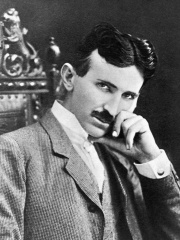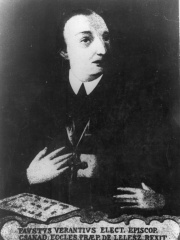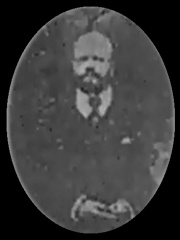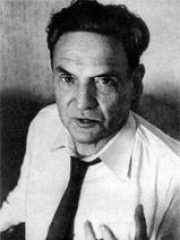



The Most Famous
INVENTORS from Croatia
Top 4
The following people are considered by Pantheon to be the most legendary Croatian Inventors of all time. This list of famous Croatian Inventors is sorted by HPI (Historical Popularity Index), a metric that aggregates information on a biography's online popularity.

1. Nikola Tesla (1856 - 1943)
With an HPI of 91.90, Nikola Tesla is the most famous Croatian Inventor. His biography has been translated into 169 different languages on wikipedia.
Nikola Tesla (10 July 1856 – 7 January 1943) was a Serbian-American engineer, futurist, and inventor. He is known for his contributions to the design of the modern alternating current (AC) electricity supply system. Born and raised in the Austrian Empire, Tesla first studied engineering and physics in the 1870s without receiving a degree. He then gained practical experience in the early 1880s working in telephony and at Continental Edison in the new electric power industry. In 1884, he immigrated to the United States, where he became a naturalized citizen. He worked for a short time at the Edison Machine Works in New York City before he struck out on his own. With the help of partners to finance and market his ideas, Tesla set up laboratories and companies in New York to develop a range of electrical and mechanical devices. His AC induction motor and related polyphase AC patents, licensed by Westinghouse Electric in 1888, earned him a considerable amount of money and became the cornerstone of the polyphase system, which Westinghouse marketed. Tesla conducted a range of experiments with mechanical oscillators/generators, electrical discharge tubes, and early X-ray imaging among other things, in an attempt to develop inventions he could patent and market. He built a wirelessly controlled boat, one of the first wirelessly controlled vehicles ever produced. Tesla became well known as an inventor and demonstrated his achievements to celebrities and wealthy patrons at his lab. He was noted for his showmanship at public lectures. Throughout the 1890s, Tesla pursued his ideas for wireless lighting and worldwide wireless electric power distribution in his high-voltage, high-frequency power experiments in New York and Colorado Springs. In 1893, he made pronouncements on the possibility of wireless communication with his devices. Tesla tried to put these ideas to practical use in his unfinished Wardenclyffe Tower project, an intercontinental wireless communication and power transmitter, but ran out of funding before he could complete it. After Wardenclyffe, Tesla experimented with a series of inventions in the 1910s and 1920s with varying degrees of success. Having spent most of his money, Tesla lived in a series of New York hotels, leaving behind unpaid bills. He died in New York City in January 1943. Tesla's work fell into relative obscurity following his death, until 1960, when the General Conference on Weights and Measures named the International System of Units (SI) measurement of magnetic flux density the tesla in his honor. There has been a resurgence in popular interest in Tesla since the 1990s. In 2013, Time named Tesla one of the 100 most significant figures of all time.

2. Fausto Veranzio (1551 - 1617)
With an HPI of 62.76, Fausto Veranzio is the 2nd most famous Croatian Inventor. His biography has been translated into 19 different languages.
Fausto Veranzio (Latin: Faustus Verantius; Croatian: Faust Vrančić; Hungarian and Vernacular Latin: Verancsics Faustus; c. 1551 – 20 January 1617) was a Croatian polymath, diplomat and bishop from Šibenik, then part of the Republic of Venice. He is a scientist recognised for his genius as both a Croatian and as a Croatian-Hungarian.

3. Josip Belušić (1847 - 1905)
With an HPI of 62.05, Josip Belušić is the 3rd most famous Croatian Inventor. His biography has been translated into 31 different languages.
Josip Belušić (Serbo-Croatian: [josip beluʃitɕ]; 12 March 1847 – 8 January 1905) was a Croatian inventor. He was born in the small settlement of Županići, in the region of Labin, Istria, and schooled in Pazin and Koper. Belušić continued his studies in Vienna, later resettling in Trieste before coming back to Istria, where he built his best known invention, the speedometer. After completing his studies, Belušić was employed as a professor of physics and mathematics at the Royal School of Koper. Later, he became director of the Maritime School of Castelnuovo, and was employed as an assistant professor in that institution. In 1887 Belušić publicly experimented for the first time with his new invention, an electric speedometer. The invention was patented in Austria-Hungary under the name of Velocimeter. Belušić exhibited his invention at the 1889 Exposition Universell in Paris, renaming it Controllore automatico per vetture. In the same year, the Municipality of Paris announced a public competition, and over 120 patents were registered to compete. His design won as the most precise and reliable and was accepted in June 1890. Within a year, a hundred devices were installed on Parisian carriages. In 1889, the Croatian newspaper Naša sloga predicted that "[Belušić's invention] will spread all over the world, and with it the name of our virtuous Istrian, friend and patriot." Belušić's invention was also the first monitoring device in history, a forerunner of measuring monitoring devices used today in trucks, buses and taxis. Thus, Belušić is also credited as the father of monitoring and surveillance devices.

4. Robert Ludvigovich Bartini (1897 - 1974)
With an HPI of 58.45, Robert Ludvigovich Bartini is the 4th most famous Croatian Inventor. His biography has been translated into 20 different languages.
Robert Ludvigovich Bartini (Russian: Роберт Людвигович Бартини; 14 May 1897 – 6 December 1974) was a Hungarian-born Soviet aircraft designer and scientist, involved in the development of numerous successful and experimental aircraft projects. A pioneer of amphibious aircraft and ground-effect vehicles, Bartini was one of the most famous engineers in the Soviet Union, nicknamed Barone Rosso (Red Baron) because of his noble descent.
People
Pantheon has 4 people classified as Croatian inventors born between 1551 and 1897. Of these 4, none of them are still alive today. The most famous deceased Croatian inventors include Nikola Tesla, Fausto Veranzio, and Josip Belušić.
Deceased Croatian Inventors
Go to all RankingsNikola Tesla
1856 - 1943
HPI: 91.90
Fausto Veranzio
1551 - 1617
HPI: 62.76
Josip Belušić
1847 - 1905
HPI: 62.05
Robert Ludvigovich Bartini
1897 - 1974
HPI: 58.45
Overlapping Lives
Which Inventors were alive at the same time? This visualization shows the lifespans of the 3 most globally memorable Inventors since 1700.

